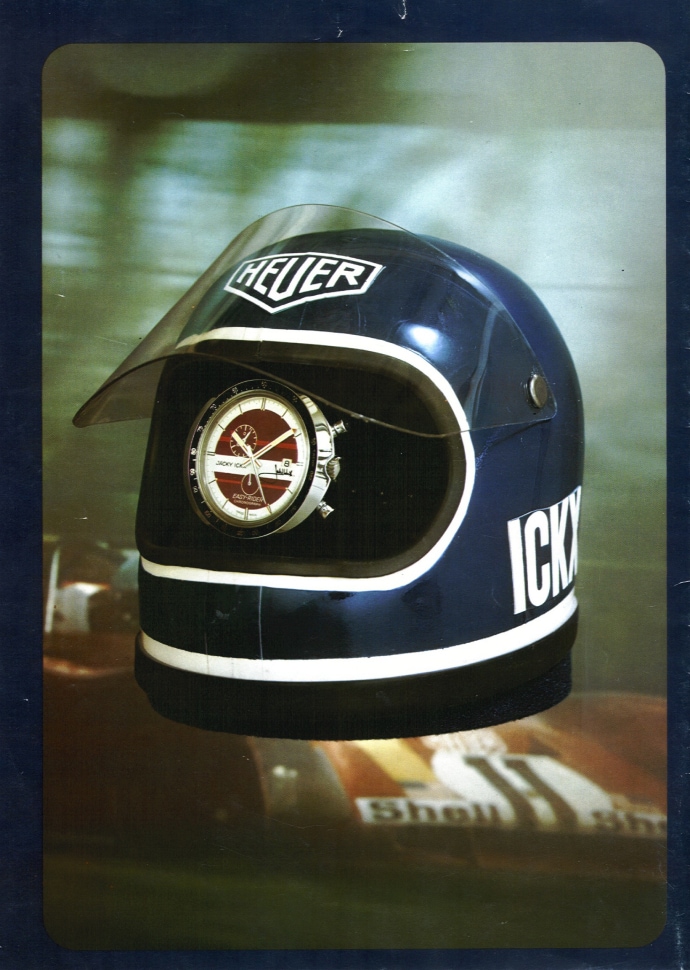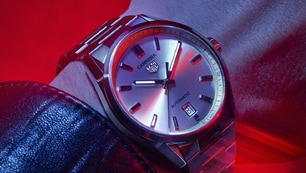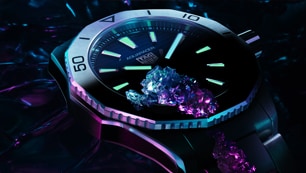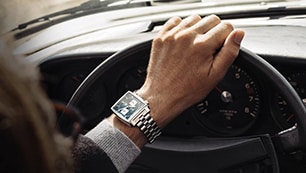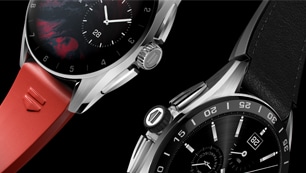
In 1970, Heuer had successfully launched its line of automatic chronographs -- with the Autavia, Carrera and Monaco – and continued to offer many chronographs powered by traditional Valjoux movements. But as Japanese manufacturers began to offer less expensive quartz watches, it became clear that Heuer needed to offer some less expensive chronographs, especially models that would appeal to younger buyers. The automatic chronographs, with the Calibre 12 Chronomatic movements were generally in the $200 range, which was a premium price in this period.
To offer less expensive chronographs that would be especially appealing to younger buyers, Heuer developed an entirely new collection of chronographs – the Easy Rider. With a forward-looking style designed for the 1970s, the Easy Rider would combine the imagery of popular culture (or, actually, the counterculture) with the romance of a handsome, accomplished motorsports hero. In 1973, the Easy Rider sold for $50, a small fraction of the price of either the Calibre 12 or Calibre 15 models, or the manual-winding Valjoux movements.
While both the imagery of the movie Easy Rider and the handsome Ferrari driver Jacky Ickx may have been attractive, the watch itself proved to be problematic, on a mechanical level. Thus the Easy Rider model did not prove to be the success that Heuer had hoped for. Still, the episode shows how Heuer employed its playbook of combining popular culture and motorsports to market its watches, and we can only imagine the success that the inexpensive Easy Rider might have achieved had the mechanical aspects of the watch been up to Heuer’s usual quality standards.
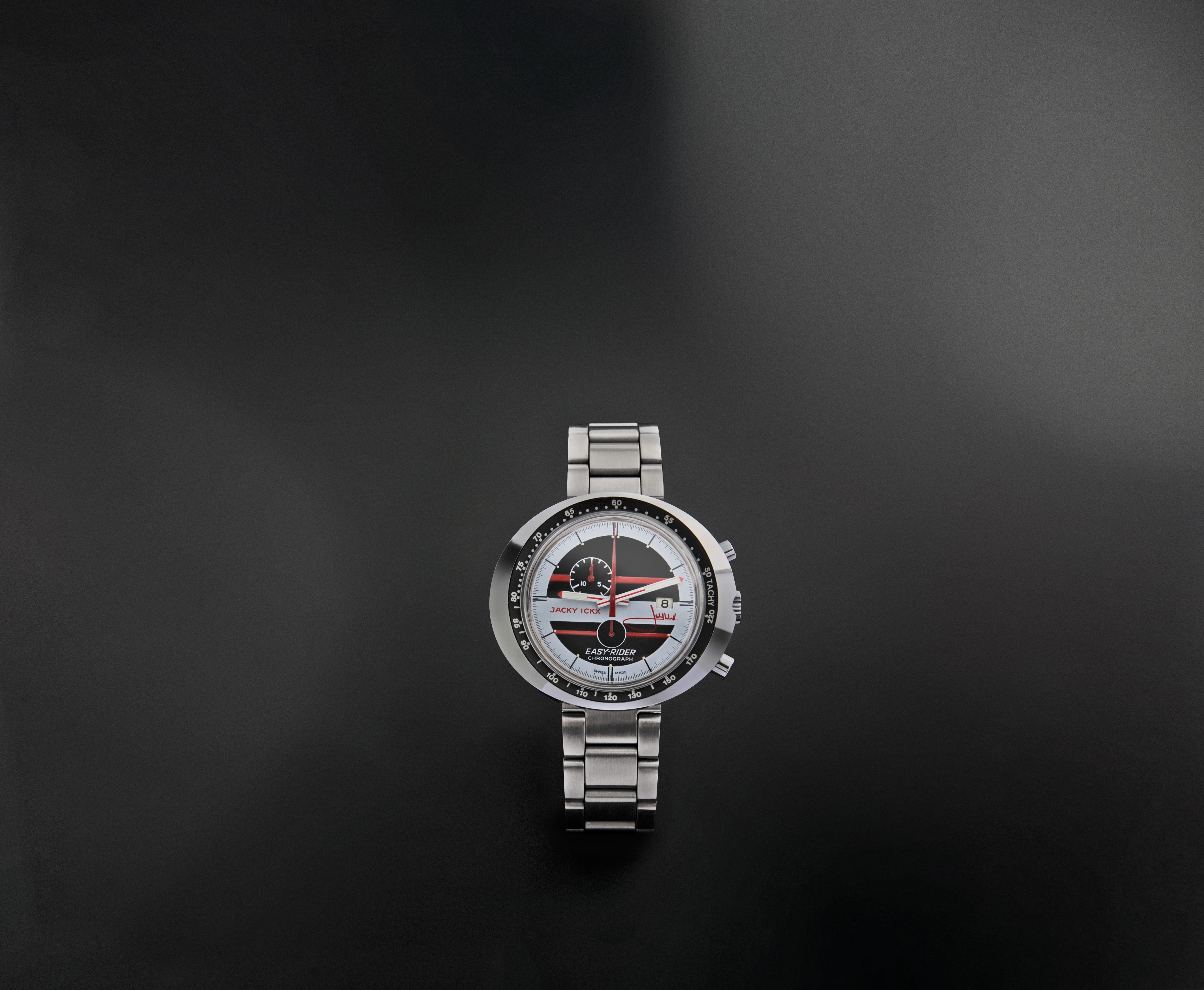
Easy Rider – The Movie
We start with popular culture in the year 1969, and the name “Easy Rider”. Filmed in 1968 and released in July 1969, the movie Easy Rider captures the spirit of the American youth counterculture that was emerging in this period. Two California hippies (played by Peter Fonda and Dennis Hopper) take illgotten proceeds and head for New Orleans on their Harley-Davidson “choppers.” Along the way, they experience free love on a commune, have numerous encounters with the “locals”, spend some time in jail, and finally reach the promised land in New Orleans.
The movie was made independently, on a budget of $400,000, although over twice that amount was spent to secure the music that became the soundtrack, with songs by The Band, The Byrds, The Jimi Hendrix Experience and Steppenwolf. The style in which Easy Rider was filmed -- with the time shifts, flash forwards and flashbacks, hand-held cameras, and sometimes improvised acting – itself represented the psychedelic experience of the late 1960s in America. Easy Rider was a huge success at the box office, grossing over $60 million, and it stands with movies such as Bonnie and Clyde and The Graduate, in commencing the so-called "post-classical Hollywood". Easy Rider represented the counterculture generation of American youth, disillusioned with the “establishment” and seeking freedom on the open road.

Jacky Ickx – The Racer
Born in Brussels, Belgium in 1945, Jacky Ickx entered Formula 1 in 1967 and finished second in the World Championship in both 1969 (driving a Brabham) and 1970 (in a Ferrari). By 1971, the first year that Heuer sponsored the Ferrari team, Ickx was the number one Ferrari driver, making him the ideal ambassador for the brand.
Despite starting the 1971 season as favorite, it was ultimately a frustrating season for Ickx, as was 1972, with Ickx finishing fourth in both years. Ickx left Ferrari in 1973 for a procession of other teams, and never got back to the top of Formula 1. Jacky Ickx is best known for his results in a category other than Formula 1: he was the King of Le Mans, winning the race 24 hour race six times (a record which was only broken by Tom Kristensen in 2008). The last of the Le Mans wins for Ickx was in the famous Rothmans Porsche 956 in 1982.

THE EASY-RIDER SERIES
Launched in December 1971, it is easiest to understand Heuer’s “Easy Rider” collection of chronographs as being comprised of four different models –
(a) Jacky Ickx Easy Rider -- The first version of the Easy Rider was housed in a chrome-plated case, with the name “Jacky Ickx” printed on the dial; dials were available in either blue, red, black or white; consistent with its premium positioning, the Jacky Ickx version of the Easy Rider has a date at 3 o’clock.
(b) Leonidas Easy Rider -- The second version of the Easy Rider was housed in a fiberglass resin case, with the cases being gray (with blue dial), yellow (with yellow dial), black (with black dial), red (with white dial) or blue (with a blue dial), and the name “Leonidas” printed on the dial
(c) Sears Chronograph – Heuer produced chronographs for American retailer Sears, Roebuck & Co., on a private label basis, with the name “Sears” and the word “chronograph” on the dial
(d) Private Label – Heuer produced chronographs for the Mathey Prevot watch brand which had only the Mathey Prevot name on the dial, but are otherwise similar to the Jacky Ickx models.
Notably, the “Heuer” brand name does not appear on any of the Easy Rider chronographs. The “Jacky Ickx” model incorporates only the racer’s name on the dial, and the fiberglass-cased models have only the “Leonidas” brand name on the dial. Heuer had acquired the Leonidas brand in 1964, and the name was soon retired, other than this reappearance on the dial of the Easy Rider. We can assume that Heuer did not want to cannibalize its existing catalog of watches by offering the far less expensive Easy Rider model (which also represented a far lower quality watch).
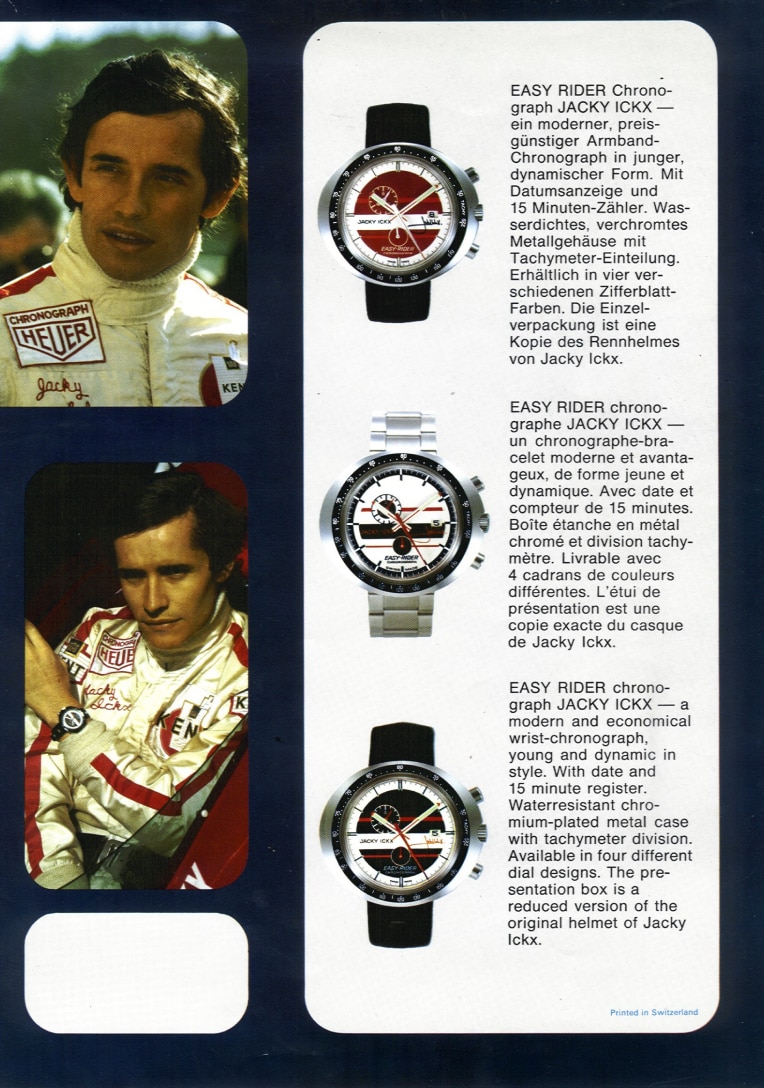
The Design
Heuer described the Easy Rider chronograph as a modern and economical wrist-chronograph, “young and dynamic in style”. Common across all four models is the use of a monocoque case, so that the movement is accessed by removing the crystal, with the case being either chromium plated of fiberglass resin. Heuer would later use the same monocoque construction on the “Temporada” model, also launched in 1971. Consistent with its style as a racing watch, a tachymeter ring was integrated into the front of the case
The chronograph has a single register that records up to 15 minutes, along with a running seconds indicator at the bottom of the dial. The chronograph operation is different from all other Heuer models, with the bottom pusher used to start and stop the chronograph, and the top pusher used to reset the chronograph (to zero). Also different from most other two-button chronographs, there is no “time in / time out” operation; as soon as the chronograph is stopped, it can be reset to zero, but cannot be restarted from its stopped position.
The Movement
The Easy-Rider was powered by the manual- wind EB8420 pin lever chronograph movement made by Ebauches Bettlach, a company that was part of ETA.
A Pin-Lever, or Pin-Pallet, movement is more typically found in relatively inexpensive alarm clocks or kitchen timers. Instead of using a lever escapement, as most chronographs do today, the system uses the vertical metal pins. This type of movement is much simpler and cheaper to make, but the metal pins have much higher friction and wear out faster. In fact, in the 19th century there were efforts to use the pin-lever as the basis for a watch that the average laborer could purchase for a price that was less than one week’s wages.
The result of this was that the Easy Rider chronograph suffered from poor reliability, especially from customers who were more accustomed to the reliability of the Heuer’s traditional movements, whether the Chronomatic introduced in 1969 or the Valjoux movements which Heuer had used since the 1930s. The unusual operation of the chronograph buttons may also have contributed to the reliability issues, with users pushing the buttons out of sequence.
The EB 8420 pin-lever movement used in the Easy Rider was different in another important respect. Ebauches Bettlach did not offer spare parts for the movement, but instead it was “standard operating procedure” for the movement to be replaced if a problem developed. Retailers and their customers did not take well to this approach, part of the reason that the Easy Rider was not the commercial success that Heuer had hoped to develop.
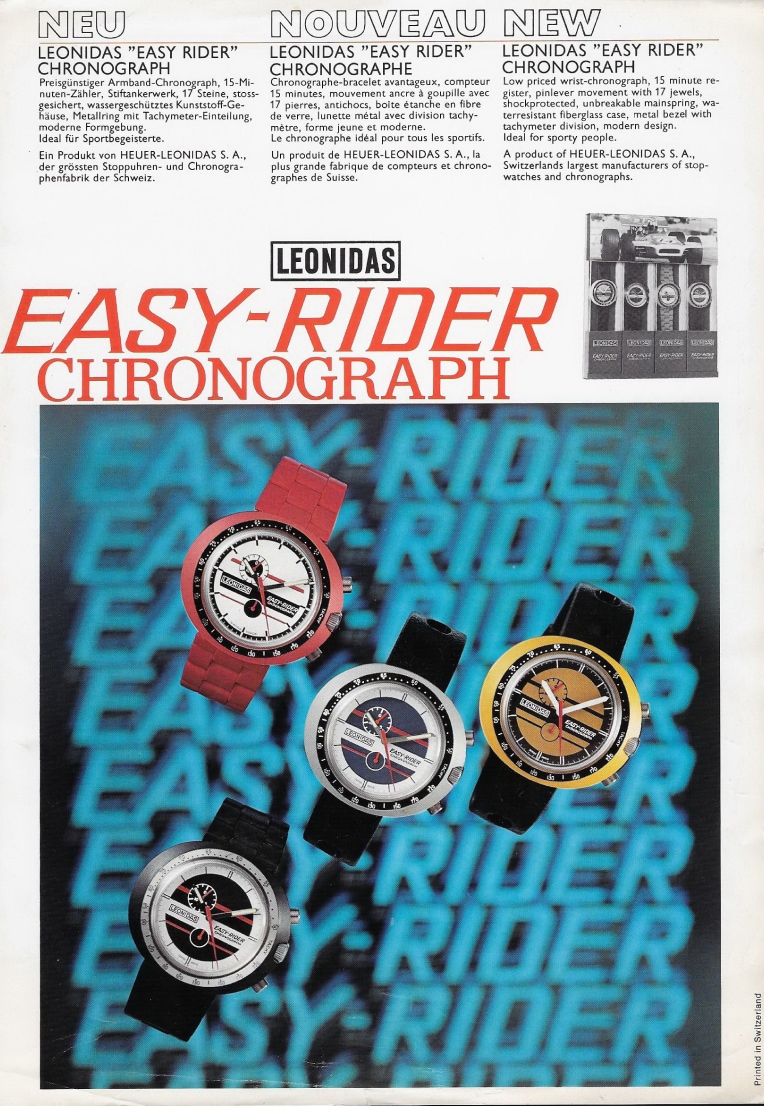
The Skipper Model
In 1968, Heuer had introduced a special model chronograph to be used in yacht racing (regatta), the Skipper. The defining feature of the Heuer Skipper was the incorporation of a 15-minute countdown recorder, which allowed the captain to time their approach to the start line of the race. The Skipper never had a dedicated case of its own, but began with a Carrera case and soon moved to an Autavia case.
There were two versions of the Easy Rider which incorporate the countdown function of the Skipper. Both versions are part of the “Leonidas” line-up, meaning that they have fiberglass resin cases, in blue. On the earlier version, the sectors of the minute recorder count down in the sequence of green, blue and white; on the later version these sectors are white, then blue, and then red. Rather than the tachymeter scale on the bezel, the Skipper models count down from 60 minutes to 0 minutes, to time the start of the race.
LEONIDAS HOBIE CAT
Heuer produced a private label version of the Easy Rider for Hobie Cat, the company that makes the small sailing catamaran of the same name.
The Hobie Cat version is essentially the same as the Leonidas-badged watch, but with Hobie Cat’s name and logo on the dial (with the deletion of the “Easy Rider” name and no reference to Heuer or Leonidas).
MATHEY PREVOT
Heuer produced a version of the Easy Rider for the Swiss watch brand, Mathey Prevot. As with other watches produced by Heuer on a private label basis, these watches have no reference to “Heuer” or “Leonidas” on the watch. The Mathey Prevot version of the Easy Rider is similar to the Jacky Ickx model, in having a chromium-plated case and a date at 3 o’clock.
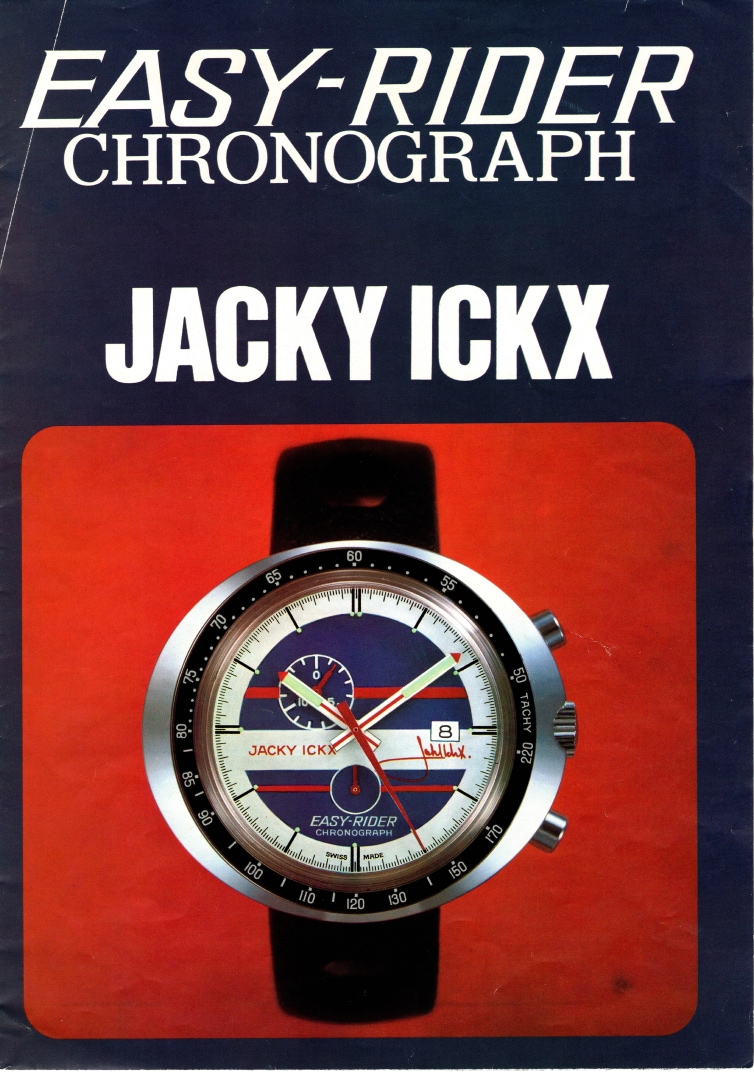
SEARS CHRONOGRAPH
Heuer made several versions of the Easy Rider for the United States retailer, Sears, Roebuck & Co. These models also have no reference to “Heuer” or “Easy Rider” on the dial, being marked only “Sears” (on the left side of the dial) and “chronograph” (on the right side). The cases are chromo-plated; dials are black, blue or white; and the watch does not include a date.
THE HELMET CLOCKS
While the Easy Rider was not a success for Heuer, at least one aspect of the watch has stood the test of time. Each Jacky Ickx Easy Rider was packaged in a presentation box that was a reduced-scale replica of the helmet for by Ickx. In time, the helmet-shaped presentation box was modified to become a “helmet clock” and these became popular among enthusiasts. As Jack Heuer explains:
“We did, however, keep in mind the idea of a low-priced product that would appeal to Formula One enthusiasts and we came up with the “Easy Rider” helmet clock. The first model was of course a Jacky Ickx helmet clock. We had agreed with Jacky to pay him one Swiss franc for every Jacky Ickx helmet sold. When other Formula One drivers saw the Jacky Ickx helmet many of them, recognising the side-income potential, wanted us to make an individual model for them as well and we went on to produce helmet clocks in the racing colours of James Hunt, Alain Prost, Carlos Reutemann, Jacques Lafitte and Clay Regazzoni, amongst others. Today, these helmet clocks are sought-after collectors’ items and change hands for many times their original price.”
